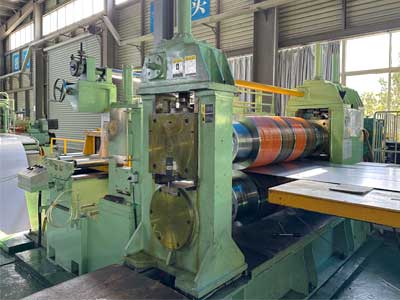Understanding Tension Control in High Speed Slitting Lines?
Tension control in high-speed slitting lines is the precise regulation of pulling force applied to a metal strip as it moves from the decoiler, through the slitting knives, and onto the recoiler. Maintaining stable tension is crucial because it must match the material’s thickness, width, hardness, and production speed. Improper tension can cause strip stretching, deformation, wrinkling, or even breakage, making balanced tension essential for smooth and accurate slitting operations.
Why Tension Control is Critical in High Speed Lines
- Ensures Accurate Slit Width
Even slight tension variations can cause the strip to shift laterally during cutting. This leads to width deviations, which may render the final product unsuitable for downstream applications.
Stable tension keeps the strip aligned with the knife shafts, ensuring tight width tolerances and consistent product quality.
- Prevents Burrs and Edge Damage
When tension is inconsistent, the strip may vibrate or move unevenly between the male and female slitting knives. This can cause:
- Rough or serrated edges
- Excessive burr height
- Premature blade wear
Controlled tension supports smooth and controlled blade engagement, producing clean, sharp edge profiles.

- Reduces Strip Breakage and Material Waste
High speed slitting lines handle large coils of expensive materials such as:
- Stainless steel
- Cold-rolled steel
- Copper and aluminum
- Galvanized and coated coils
Incorrect tension may stretch or crack the strip, resulting in coil rejection and significant financial loss. Precision tension control minimizes scrap rate and helps maintain production efficiency.
- Prevents Telescoping and Poor Recoil Quality
The recoiler forms new coils from the slit strips. If tension is not uniform:
- Coils may become loose or telescoped
- Edges may shift or appear uneven
- Transport and storage may become difficult or unsafe
Stable tension ensures tight, uniform rewind coils suitable for packaging and further processing.
- Extends Blade and Machine Component Life
Fluctuating tension increases stress on:
- Slitting knives
- Spacer rings
- Bearings
- Gearbox and drive systems
A controlled and uniform tension range reduces mechanical shock and vibration, which extends the lifespan of machine components and lowers maintenance costs.
How Tension Control is Achieved in Modern Slitting Lines
Professional slitting lines, such as those designed by LOTOS SLITTING, utilize advanced tension management technologies, including:
System | Function |
Dancer Roll System | Automatically adjusts tension based on material speed and movement |
Pneumatic / Hydraulic Brakes | Provides consistent drag control at the decoiler |
Servo-Driven Motors | Maintains precise torque and speed synchronization |
Automatic Feedback Loops (Closed-Loop Control) | Corrects tension in real-time for high-speed accuracy |
These systems work together to keep the strip movement stable throughout the slitting process.
Choosing a Slitting Line With Proper Tension Control
When evaluating a slitting line, manufacturers should consider:
- Material type (mild steel, stainless steel, copper, aluminum)
- Coil thickness and width range
- Production speed requirements
- Tolerance requirements
- Recoil packaging specifications
An effective slitting line must adapt tension dynamically depending on the production stage and material properties.
Why LOTOS SLITTING is a Reliable Choice
LOTOSSLITTING provides slitting lines engineered for stable, precise, and efficient operation in industrial environments. Our machines feature:
- Advanced tension control systems
- Precision knife arrangement and spacer tolerance
- High-speed servo synchronization
- Customizable configurations based on application needs
- Professional commissioning & operator training
Whether for light gauge, medium gauge, or heavy gauge coil processing, LOTOS delivers solutions that ensure consistent quality and high productivity.
Tension control is a vital performance parameter in high-speed slitting lines. Proper tension management results in:
- Accurate strip width
- Clean edge quality
- Reduced material waste
- Extended machine life
- Stable and uniform recoiling
For manufacturers seeking high-quality slitting performance, selecting a system with precise automatic tension control is not optional—it is essential.
LOTOSSLITTING designs and supplies advanced slitting lines engineered for accuracy, durability, and productivity in demanding coil processing applications.
Tension control is the regulation of coil tightness during unwinding, slitting, and rewinding to ensure stable and accurate strip output.
Incorrect tension can cause coil shifting, blade misalignment, poor edge finish, and inconsistent strip dimensions.
Modern slitting lines use closed loop automation to continuously monitor and adjust tension throughout the process.
Tension control typically uses load cells, dancer rolls, brake systems, and feedback automation to maintain stable coil pressure.
